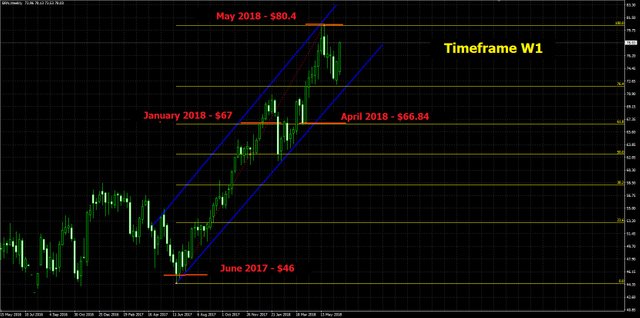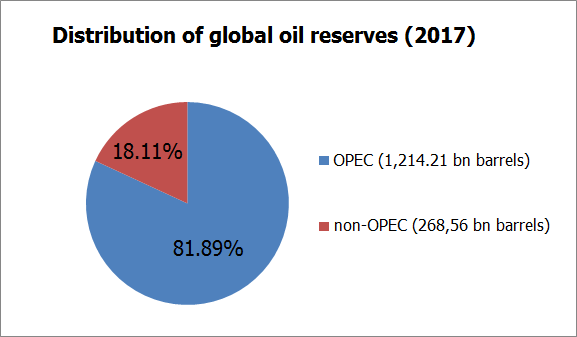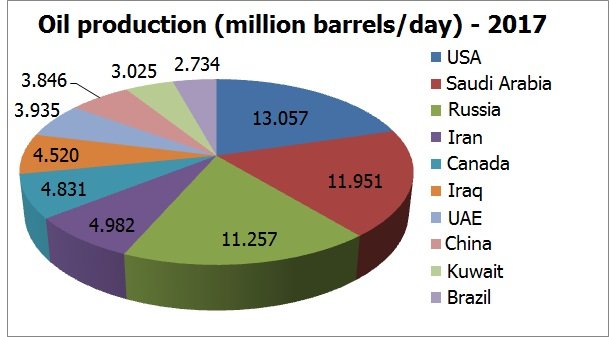The prospects for the oil market in the second half of 2018
Technical analysis

As of June 2018, Brent oil prices have risen by more than 70% since last summer, when it was trading at just 46 USD a barrel. At the turn of the year, oil was valued at 67 USD a barrel, as seen in Fig 1. As of now, oil is still moving within this upwards channel. The highest prices seen this year were in May, when the 80 USD per barrel mark was broken. At the moment, oil is trading above the 76.4 Fibo level at around 78 USD per barrel.
In answering the question of how much oil will cost at the end of the year, I’m considering two different ways this could pan out. Firstly, there’s a high likelihood that oil will once again test the 100 Fibonacci level and try to break through 80 USD per barrel. The second possibility is that prices will move towards the 76.4 Fibo (72 USD per barrel), which intersects the trend line. This bearish movement could then gain some momentum, bringing oil down to the 61.8 Fibo at 67 USD per barrel. This type of scenario will be possible if oil-producing countries significantly step up their production, or if the current trade war being witnessed leads to slowed global economic growth.Source: "Forecast for oil for the second half of 2018"

Fig 1. BRN weekly chart.
The alignment of forces on the global oil market
According to OPEC data, the known oil reserves of member countries in 2017 make up 81.89% of global reserves (1,214.21 bn barrels), with the remaining 18.11% (268.56 bn barrels) coming from non-OPEC countries as seen in Diagram 1. The lion’s share of reserves among OPEC member comes from just 4 countries: Venezuela, Saudi Arabia, Iran, and Iraq (table 1).Source: "Forecast for oil for the second half of 2018"

According to the BP Statistical Review of World Energy 2018 published on 13/06/18, these are the top 10 countries in the world in terms of oil reserves as of 2017:
Venezuela – 303.2bn barrels
Saudi Arabia – 266.2bn barrels
Canada – 168.9bn barrels
Iran – 157.2bn barrels
Iraq – 148.8bn barrels
Russia – 106.2bn barrels
Kuwait – 101.5bn barrels
UAE – 97.8bn barrels
USA – 50.0bn barrels
Libya – 48.4bn barrels
Production in the US rose by 5.6% in 2017 compared to 2016. Over the same period, production in Saudi Arabia and Russia decreased by 3.6% and 0.1% respectively. This decrease is the result of agreements made by OPEC+ in 2016.Source: "Forecast for oil for the second half of 2018"
Diagram 2

Geopolitics and the oil market
Another OPEC+ meeting was held on the 22nd of June. As expected, the decision was made to increase production by a million barrels a day. Remember that in 2016, the OPEC+ members had agreed to reduce production by 1.8m barrels a day. Today, production is 2.8m barrels a day lower than it was back then. As such, production level should reach the initially agreed upon amount in the second half of 2018.
These days, the global oil market finds itself under the influence of political factors. The USA’s withdrawal from the Iran nuclear deal as well as threats of additional sanctions, a drop in production in Venezuela, as well as production across all OPEC+ countries dropping by more than the agreed upon amount have all contributed to the recent rapid growth in oil prices.
According to an OPEC report on the oil market in June, demand in 2018 is set to rise to 98.85m barrels a day against 97.2m in 2017.
As it appears, in order to satisfy the demand for black gold, OPEC members will need to ramp up production by more than 1 million barrels a day before prices begin to stabilise.
High oil prices are good for the US given the high costs of production and sale of shale oil. As such, the US will be looking to do what they can to bring oil prices up. This is where we can see the logic behind Trump’s actions towards Iran, which is to be expected as the US needs somewhere to sell its produce, and one of the biggest markets; Europe, is currently flooded with cheap Russian oil.
In my opinion, there are two different ways that oil prices could pan out over the remainder of 2018. The first scenario envisages an increase in oil production from OPEC+ countries sufficient to keep up with demand, in which case oil prices will consolidate within a corridor of 70-75 USD per barrel. The second scenario is that prices will break 80 USD per barrel, with the potential to reach 100 USD.Source: "Forecast for oil for the second half of 2018"
Congratulations @mohammadazizi220! You have completed the following achievement on the Steem blockchain and have been rewarded with new badge(s) :
You can view your badges on your Steem Board and compare to others on the Steem Ranking
If you no longer want to receive notifications, reply to this comment with the word
STOPVote for @Steemitboard as a witness to get one more award and increased upvotes!
Congratulations @mohammadazizi220! You received a personal award!
You can view your badges on your Steem Board and compare to others on the Steem Ranking
Vote for @Steemitboard as a witness to get one more award and increased upvotes!